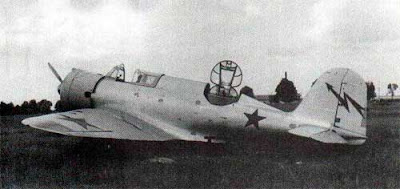In 1938 a variant, the KhAI-5bis was tested with an M-25E engine, achieving a speed of 425 km/h (264 mph). In 1938, the KhAI-52 ground attack aircraft, based on the R-10, was also developed. It was powered by an Shvetsov M-63 670 kW (900 hp) radial engine and armed with seven machine guns and 400 kg (880 lb) bombs. A production run of an experimental series of 10 aircraft was prepared, but it was cancelled with Nyeman's arrest.
Some production R-10s were fitted with more powerful Tumansky M-88, Shvetsov M-62 and M-63 engines. Over 60 aircraft, withdrawn from the Air Force, were used from 1940 as mail carriers by Aeroflot, under the designation PS-5 (Russian: ПС-5), with 3 passenger seats.
The aircraft entered service in the Soviet Air Force in 1937, replacing some Polikarpov R-5s. R-10s were first used in combat in the 1939 Soviet-Japanese Battle of Khalkhin Gol. Then, they were used in the initial stage of the World War II, starting with use against Poland in the Invasion of Poland (without combat encounters) and against Finland in the Winter War (1939–1940).
R-10s were next used in the first period of the German-Soviet war, following the German attack on June 22, 1941. By this time, they were outdated and suffered heavy losses, as did the rest of the Soviet Air Force. Many planes were destroyed on the ground. They were used as tactical reconnaissance aircraft, and, in need, also as light bombers. Later many were used as night bombers, to reduce losses from opposing fighters. The remaining R-10s were withdrawn from combat service in 1943 although two Finnish pilots claimed R-10s in 1944.
The aircraft was conventional in layout, with low mounted, plywood-covered wooden wings. The fuselage was of semi-monocoque construction. The undercarriage retracted into the wings. The crew consisted a pilot and an observer/rear gunner in a turret with a single machine gun. In the observer compartment's floor there was an AFA-13 camera for reconnaissance duties. Between the crew compartments there were fuel tanks and a vertical bomb bay.
The maximum bomb load was 300 kg (660 lb) (6 × 50 kg (110 lb) or 10 × 25 kg (55 lb) bombs). The plane was powered by various variants of the Shvetsov M-25 and related M-63 radial engines, a development of the Wright R-1820 built under licence, which spun an all-metal two-bladed Hamilton Standard variable-pitch propeller.
Operators
Soviet Air Force
General characteristics
Crew: 2
Length: 9.3 m
Wingspan: 12.2 m
Wing area: 26.8 m2
Empty weight: 1,823 kg
Gross weight: 2,515 kg
Fuel capacity: 260 kg (573 lb) fuel + 30 kg (66 lb) oil
Powerplant: 1 × Shvetsov M-25 9-cyl. a-c radial piston engine 531 kW (712 hp)
(license-built Wright SGR-1820-F-3 Cyclone)
Propellers: 2-bladed Hamilton Standard two-pitch propeller
Maximum speed: 350 km/h at sea level
388 km/h (241 mph) at 2,500 m
Landing speed: 125 km/h
Range: 1,450 km
Service ceiling: 7,700 m
Time to altitude: 1,000 m in 2 minutes 24 seconds
5,000 m (16,404 ft) in 12 minutes
Take-off distance: 250 m
Landing distance: 230 m
Guns: 2 x fixed forward firing 7.62 mm ShKAS machine-guns
1 x manually aimed ShKAS machine-gun in the rear turret
Bombs: 6 x 50 kg (110 lb) FAB 50 bombs in internal bays






Ei kommentteja:
Lähetä kommentti
Kaikenlaiset kommentit ovat tervetulleita.